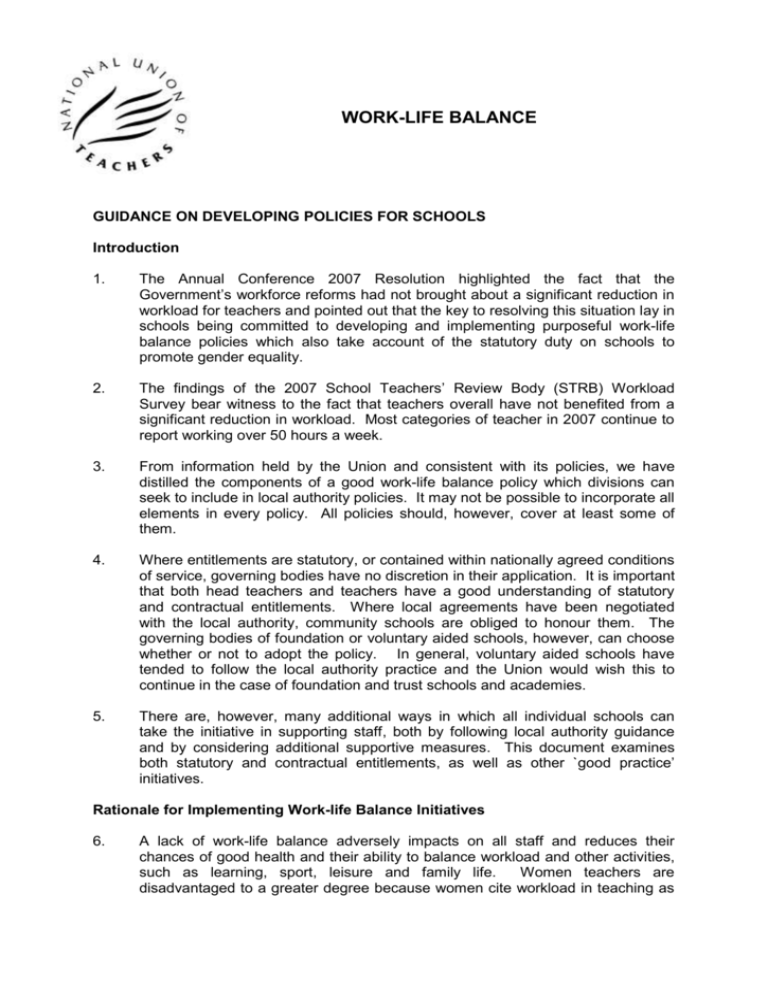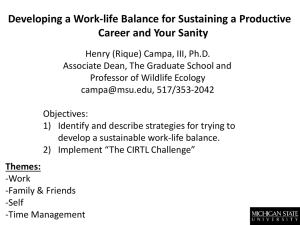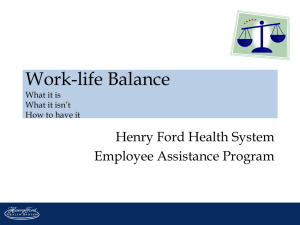WORK/LIFE BALANCE
advertisement

WORK-LIFE BALANCE GUIDANCE ON DEVELOPING POLICIES FOR SCHOOLS Introduction 1. The Annual Conference 2007 Resolution highlighted the fact that the Government’s workforce reforms had not brought about a significant reduction in workload for teachers and pointed out that the key to resolving this situation lay in schools being committed to developing and implementing purposeful work-life balance policies which also take account of the statutory duty on schools to promote gender equality. 2. The findings of the 2007 School Teachers’ Review Body (STRB) Workload Survey bear witness to the fact that teachers overall have not benefited from a significant reduction in workload. Most categories of teacher in 2007 continue to report working over 50 hours a week. 3. From information held by the Union and consistent with its policies, we have distilled the components of a good work-life balance policy which divisions can seek to include in local authority policies. It may not be possible to incorporate all elements in every policy. All policies should, however, cover at least some of them. 4. Where entitlements are statutory, or contained within nationally agreed conditions of service, governing bodies have no discretion in their application. It is important that both head teachers and teachers have a good understanding of statutory and contractual entitlements. Where local agreements have been negotiated with the local authority, community schools are obliged to honour them. The governing bodies of foundation or voluntary aided schools, however, can choose whether or not to adopt the policy. In general, voluntary aided schools have tended to follow the local authority practice and the Union would wish this to continue in the case of foundation and trust schools and academies. 5. There are, however, many additional ways in which all individual schools can take the initiative in supporting staff, both by following local authority guidance and by considering additional supportive measures. This document examines both statutory and contractual entitlements, as well as other `good practice’ initiatives. Rationale for Implementing Work-life Balance Initiatives 6. A lack of work-life balance adversely impacts on all staff and reduces their chances of good health and their ability to balance workload and other activities, such as learning, sport, leisure and family life. Women teachers are disadvantaged to a greater degree because women cite workload in teaching as incompatible with raising their family as they struggle to discharge caring responsibilities. 7. Where reluctance is expressed on the part of local authorities to establish guidance for schools/model policies, or negotiate local agreements, or where schools are reluctant to implement their own policy, the arguments set out below may prove persuasive. (a) Work-life balance is about helping staff combine work with their personal commitments and interests. Good work-life balance is an essential factor in staff effectiveness and satisfaction, which in turn supports pupil learning. It is, therefore, in the interests of schools to adopt policies that allow employees to balance their working lives with their personal needs and interests, and caring responsibilities. The introduction to any work-life balance policy should emphasise this key point. (b) The Equality Act 2006 amended the Sex Discrimination Act 1975 to place a `general duty’ on all local authorities and schools in England and Wales, when carrying out their activities, to have regard to the need: to eliminate unlawful discrimination and harassment; and to promote equality of opportunity between men and women. Schools and authorities are required to publish gender equality schemes. Providing opportunities for male and female teachers to balance their work with other aspects of their life will help reduce the disadvantage experienced by women working within the teaching profession. (c) Head teachers are required by their conditions of employment (see below for more details) to address this area. Governing bodies also have health, safety and welfare responsibilities. See section below ‘Who is responsible for improving work-life balance’ for more information on health and safety responsibilities. (d) Attention to work-life balance issues also has other ‘knock on’ effects, including: reduced stress and sick leave, leading to financial savings on supply cover; improved outcomes for pupils in primary classes in particular where classroom teachers are not affected by ill health absence; a more motivated workforce with high morale; better communication within the workplace; making it easier for disabled teachers to stay in the profession when they acquire impairments or impairments change; improved pupil behaviour and learning as staff wellbeing increases (TSN survey); promoting gender equality, because the long hours associated with full time teaching contracts discourage women seeking promotion and mean women are over represented in part time teaching; a recognition that working excessive hours might actually reduce staff effectiveness. Staff should be valued for their skills, experience and contribution, not their working pattern; increased job satisfaction; fewer problems with recruitment and retention – a good work-life balance policy will give schools an ‘edge’ when seeking to attract and retain staff of the highest calibre; work-life balance is not mainly about doing less – it is about maintaining, or even raising, performance by living healthier, more productive, lives. Who is Responsible for Improving Work-Life Balance in Schools? Health and Safety Duties 8. Local authorities, where they are the employers, bear overall responsibility for safeguard, so far as is reasonably practicable, the health, safety and welfare of employees. Governing bodies, where they are the employers, carry this responsibility in, for example, voluntary aided and foundation schools. 9. Head teachers have a professional duty as set out in Section 2, Part 9, paragraph 57.3 of the 2007 School Teachers’ Pay and Conditions Document to ‘have regard to the desirability of teachers at the school being able to achieve a satisfactory balance between the time required to discharge their professional duties ... and the time required to pursue their personal interests outside work’. 10. Even where the governing body is not the employer, it has a duty under the Equality Act 2006 to assess the impact of its policies on gender equality and issue a scheme with gender equality objectives. Improving work-life balance for all teachers will be a key way of improving gender equality. What about the Head Teacher’s Work-Life Balance? 11. Head teachers are entitled to a reasonable amount of time during school sessions for the purpose of discharging leadership and management responsibilities. 12. It is up to Governing bodies to ensure that head teachers are able to take this time, which is known as ‘Dedicated Headship Time’. In some cases governing bodies and head teachers may need to discuss reducing the head teacher’s teaching commitment so as to reduce the need to work on school business at weekends. An increase in headship time must not, however, lead to additional workload for other overburdened teachers. Governing bodies will, in such cases, need to consider additional staffing. More detailed advice on work-life balance for head teachers follows later in this guidance document in the section headed ‘The Position of the Head Teacher’. Key Aims of a Work-Life Balance Policy 13. The key objectives of a work-life balance policy are described below. To acknowledge that staff need to balance work commitments with other aspects of their life and to assist in this process so that staff can achieve their best at work and manage other areas of their life effectively. To help address the problem of excessive workload among teachers. To recognise that long working hours have a negative impact on all families, as well as teaching and learning. To benefit the school and its employees. To acknowledge the need for management, governors, employees and trade unions to work together to identify realistic solutions to improve work-life balance. To make employees feel valued and to foster mutual respect. To acknowledge that the needs of both the school and its staff will change over time. To reduce physical and mental ill health of staff. To communicate good practice to staff on a regular basis so that they are reminded of the provisions from which they can benefit as and when their circumstances change. To operate in a fair and consistent manner. It is important that work-life balance is not simply viewed as a benefit for working parents but as a way of organising work so that all staff have a life outside school, which could include learning, sporting, leisure or other interests. Other staff, for example those with caring responsibilities for disabled or elderly relatives, should not feel that a good work-life balance approach simply favours those with children. Staff who do not have children must not automatically be expected to assume the workload of working parents who have been granted leave of absence. This would be unfair and would generate resentment and division among staff. EXAMPLES OF GOOD PRACTICE IN WORK-LIFE BALANCE PROVISION 14. The rest of this document comprises information on statutory entitlements and NUT policy on work-life balance issues, as well as examples of good practice extracted from local authority and school policies. Together this information represents the basis for a sound approach to work-life balance. Role of the Governing Body 15. Nomination of a work-life balance Governor with responsibility for promoting and monitoring work-life balance in the school is a sensible first step, particularly for schools which have thus far not given much consideration to work-life balance issues. Giving responsibility to a governor should help kick-start the whole process. Consultation with staff 16. The involvement of staff is the key to the success of any policy. A good place to start is to find out what problems staff have with their current working arrangements and ask what options would help staff balance work and home lives. Set out below are various examples of what form such consultation should take. - Regular review, discussed at annual staff meetings, of how effectively the school is taking into account the work-life balance of all staff. - Consultation with staff on the timing of meetings, INSET, Report Schedules, school trips etc., when drawing up the calendar for the academic year. 17. Calendars should include all the above, as well as concerts, open days, sports days, activity weeks and other events that sill impact on work-life balance. If teachers know what is coming up, and when, they can adjust their own workload. For example, they can set homework which requires less marking or which can be marked by pupils in class, if reports need to be written or an evening event is taking place. 18. Employees who are members of a recognised union are entitled to take a reasonable amount of unpaid leave during the working day to take part in union activity. Because there is no statutory right to paid leave for union activities, union meetings tend to take place after school. Good teacher/management relations can be fostered by schools agreeing not to hold after-school meetings on days when trade union meetings have been arranged, provided that reasonable notice of such meetings has been given. - All new initiatives, for example, extended schools, to be considered in terms of their impact on work-life balance. - Properly conducted exit interviews, or use of exit questionnaires, when staff resign to find out if problems with work-life balance led to the resignation. - Consultation between the head or deputy head and NQTs, new appointees, and those promoted internally, 6 weeks after they take up their new post, to explore work-life balance issues and to see if the school can offer further support. - Clear and up-to-date identification of duties and responsibilities, relating to individual teacher’s roles in job descriptions and consultation prior to any changes. 19. The Equality Act 2006 requires governing bodies to consult staff in order to gather information upon which to base gender equality objectives for the school’s scheme. Time off in Lieu 20. Provision of time off in lieu for staff who volunteer to stay late for additional, untimetabled meetings could involve permission to leave early or come in late on another day. Another example where such an arrangement could operate is for Open Evenings for prospective Year 7 or Year 12 pupils and parents. Schools could choose to close early on the day of the Open Evening, to allow staff extra time to prepare classroom displays, and take a break, and could open an hour later than normal the following morning to compensate for the late working required. Such a policy would ensure that teachers take the 11 consecutive hours’ rest, in a 24 hour period, which is their entitlement under the Working Time Regulations 1998. Training 21. Working with all staff, including those who work part-time, to provide appropriate training to enable them to do their jobs effectively within normal hours. 22. Ensuring that training, including CPD, takes place during the school day, not at the end of the day when staff are tired and less able to concentrate. Facilities/Equipment 23. Consideration as to whether on-site child care facilities can be provided. 24. Purchase of equipment, for example laptops, to help staff work more efficiently. 25. Provision of suitable workplace facilities for rest and relaxation and, separately, for PPA time and healthy lunches. Welfare 26. Arrangements to allow even those staff who are on playground duty time for a drink and short break, or for TAs to cover break times and then take their break afterwards. 27. Celebrations for staff birthdays. 28. Parents’ evenings changed to Parents’ days or Academic Review Days. Working at home 29. Many people feel that they are at their most productive when working at home without distraction. The introduction of ‘Home Admin Days’ may, therefore, be welcomed by many staff working on significant curriculum projects or Annual Reviews/Reports. Provided that such days are agreed in advance, recorded in the office calendar, and that staff are contactable at home during school hours, such days should not be detrimental to the efficient running of the school. 30. Some teachers will wish to work at home during their PPA time. For others it may not be feasible, because of the timing of their PPA time or because of where they live. Decisions on whether to allow teachers to work at home during their PPA time are at the discretion of the head teacher. It is hoped, however, that, subject to appropriate monitoring systems, many head teachers will be persuaded that teachers do not necessarily have to be on the premises to undertake certain tasks. Time set aside at home can help teachers to focus on tasks and can be a highly efficient and cost effective way of working. 31. Where PPA time is taken on the school premises, it is essential that teachers have access to appropriate work areas, free from interruption. Without such access, work which should be able to be completed during the school day, will need to be completed at home, with inevitable impact on work-life balance. Organisation of Meetings 32. Sensible arrangements for meetings are a key element in any work-life balance policy and are essential to prevent meetings encroaching on time when teachers should be at home. 33. NUT policy is that meetings should last no more than 60 minutes, be held on no more than an average of one evening per week during term time, with a maximum of two evenings in any week. Pre-school briefings should be within this 60 minute maximum. 34. Meetings should be timetabled at the beginning of the academic year and should have a clear purpose. Only staff whose presence is essential should attend. 35. Part-time teachers should not be required to attend meetings at times when they are not on the premises, unless this has been taken into account in the terms of their contract. Due to other commitments, many part-time teachers will be unable to come into school at times when they are not timetabled to work. Head teachers should respect this position and should not seek to direct teachers to work in circumstances where such a direction would be unreasonable. 36. More information about meetings is contained in the NUT document ‘Teachers’ Working Time and Duties’ available on Hearth and www.teachers.org. Flexible working 37. Work-life balance policy should support, as far as is reasonably possible, requests for flexible working from both men and women teachers. 38. Teaching is a challenging, at times exhausting, profession to work in. Combining it with parental responsibilities, or any other kind of caring responsibilities can be too much for some teachers. One way of preventing the loss of experienced colleagues is for a school policy to promote flexible working and be supportive of reasonable requests for time off. 39. The term flexible working covers a wide range of practices, including job share, part-time working, time off for family and domestic reasons, and parental leave. 40. There are minimum statutory requirements which local authorities and schools must adhere to, and which are described below. The best employers will, however, seek to go beyond the minimum required by law. It is important that work-life balance policies make teachers aware of the minimum statutory provisions described below, as well as any improvements in place through local agreements. 41. As stated earlier in this document, where divisions are able, by virtue of local agreements, to incorporate superior provisions into teachers’ conditions of service, these provisions will apply to all teachers employed by the authority. To ensure a ‘level playing field’ in terms of recruitment and retention, however, other types of school, including foundation, voluntary aided and trust schools, as well as academies might be prepared, if approached, to match the local authority improvements, rather than applying statutory minimums. 42. A school work-life balance cannot ignore gender. It requires consideration of how to reduce and remove the gender discrimination which exists within the teaching workforce, as it does in every sector of the workforce. School work-life balance policies should: 43. aim to remove the economic disadvantages suffered in terms of pay, progression and pension by those to whom current gender norms allocate greater caring responsibilities (currently, women); challenge current gender norms by enabling families to share caring responsibilities more equally between men and women; acknowledge the value to society of the unpaid ‘care’ that employees juggle outside their paid employment; acknowledge that increasingly all adults wish to contribute to both caring and paid employment. It is important that school work-life balance policies and flexible working policies enable male teachers to become more involved in caring for babies and children. It is important also that policies do not encourage gender stereotypes or reinforce gender inequalities in the home or in employment by assuming that caring is female. Statutory Right to Request Flexible Working 44. Male or female teachers may request a change to their hours, time or work or place of work in order to care for a child under the age of 6, a disabled child under the age of 18, or an adult aged 18 or over who is related to, or living at the same address as, the employee. There is unfortunately no absolute right to be granted the request. Formal requests for flexible working can only be made under the Flexible Working Regulations every 12 months. 45. A good work-life balance policy would, therefore, point out that there is nothing to prevent staff from submitting informal requests for flexible working since these are not covered by the Regulations. 46. The long hours working culture in schools undermines the right to request flexible working. Both issues are connected in policy terms. Unless the dominant school culture is seen to be supportive of reducing working hours for all teachers, including men, then not all carers/parents will take advantage of the right to request flexible working and the policy will not achieve its aims. The greater the difference in hours between full time teachers and those working “flexibly”, the more likely the latter will be penalised in terms of pay, career development and promotion. 47. Divisions who require more information on the right to request flexible working will find an NUT guidance document on Hearth and on www.teachers.org. Statutory Right to Unpaid Time Off for Family and Domestic Reasons 48. All employees have a legal entitlement to take unpaid time off to deal with incidents involving employees’ dependants. A dependant is defined as: a spouse or civil partner; a child; a parent; a person living in the same household, other than as an employee, tenant, lodger or boarder. 49. By this definition, partners of the opposite or same sex and living together, will be classed as dependants. 50. A dependant is also any person who reasonably relies on the employee for assistance on an occasion when the person falls ill or is injured or assaulted, or to make arrangements for the provision of care in the event of illness or injury. This will include, for example, elderly relatives or same sex or opposite sex partners not living in the same household but reliant on the employee to assist them in the event of illness or injury. A dependent is also any person who reasonably relies on the employee to make arrangements for the provision of care. 51. No qualifying period of service is required, and all employees have the right to time off. A “reasonable” amount of unpaid time off is allowed, although there is no definition of what is “reasonable” and it will, therefore, vary according to each case and each set of circumstances. 52. As noted above, the statutory right to unpaid time off for domestic and family reasons is entirely separate from, and additional to, any entitlement to parental or maternity leave. 53. A good work-life balance policy will allow some element of paid leave to assist with incidents involving dependants. See `Leave of Absence’ section below. Leave of Absence 54. Work-life balance policies should recognise the difficulties that teachers face because they do not have the same flexibility to take annual leave as other employees. 55. It is important, therefore, that local authorities and trade unions negotiate local agreements which specify minimum levels of paid leave for different circumstances. As described in the introduction to this guidance document, such agreements will apply automatically in community and voluntary-controlled schools but will only apply in voluntary aided and foundation schools if the governing body has agreed to adopt them. Head teachers can then use their discretion to grant additional unpaid or paid leave. Examples of reasonable arrangements are listed below. Note that this is not an exhaustive list. 56. Examinations – paid leave to attend the examination and award or degree ceremony. Discretionary study leave. 57. Interviews – up to 3 days’ paid leave per year for teachers seeking an alternative post within any local authority. 58. Funerals of close relatives/friends – paid leave as necessary. 59. Wedding or civil partnership of a near relative – one day’s paid leave. 60. Medical appointments/medical screening – where possible teachers should arrange these in their own time but where this cannot be arranged, paid time off will be granted. Paid time off must, however, be granted for ante-natal appointments. 61. Moving house – one day’s paid leave if on a school day. 62. Time off to care for a sick child or other dependant – paid leave as necessary. 63. Public duties – Section 50 of the Employment Relations Act 1996 gives a statutory right to time off for public duties. The Burgundy Book provides that ‘teachers shall have entitlements comparable with those of local authority officers so far as paid and unpaid leave entitlement is concerned for jury and other public service’. Reasonable time off should, therefore, be granted for public duties or for serving on public bodies, including service as: Justices of the Peace; members of local authorities; governors of schools; members of a police authority; members of any statutory tribunal; members of advisory bodies of trade unions; members of the General Teaching Councils for England and Wales; members of a health authority or a primary care trust. 64. Where a teacher can claim an allowance for loss of earnings, this should be done, and the school will then deduct this from the teacher’s pay. 65. Schools could also demonstrate their commitment to supporting teachers with young children by considering requests for limited amounts of time off to attend their children’s Christmas or end of Summer Term performances. Such requests would generally only amount to an hour or two away from school but agreeing such requests, provided they are submitted well in advance, would generate large amounts of good will among staff concerned. 66. If such requests are genuinely problematic, a practical solution would be to allow teachers to attend during their PPA time, or swap/rearrange their PPA time with colleagues so as to facilitate their attendance without increasing workload for those teachers who do not need time off. Time off for Religious Observance 67. Under the Employment Equality (Religion or Belief) Regulations 2003 it is unlawful to discriminate against workers because of their religion or belief. The regulations do not say that employers must provide time off and facilities for religious or belief observance in the workplace. It is, however, good practice for employers to consider whether their policies indirectly discriminate against staff of particular religions or beliefs and, if so, whether reasonable changes could be made. There is always a balance to be struck, but in general the NUT advises that schools should seek to be sufficiently flexible to accommodate a teacher’s religious observance where that is reasonably practicable. Time off for Fertility Treatment 68. The NUT believes that schools should deal appropriately and sensitively with requests for time off for fertility treatment. The NUT believes also that paid leave of absence should be given for medical appointments for initial infertility investigations and for other medical appointments during the treatment cycle and should not be counted against the teacher’s sick leave entitlement. Sickness absence resulting from the treatment should be counted against the teacher’s sick leave entitlement in the usual way. The nature of the treatment may mean that absences cannot always be planned in advance but it is reasonable to expect teachers to give as much notice of the need for time off as is possible. 69. Requests for time off for fertility treatment are not likely to come from large numbers of teachers at any one school. This fact, together with the possibility of falling foul of sex discrimination legislation may encourage local authorities/schools to be supportive of teachers. 70. Seeking, undergoing and, in many cases, paying for, fertility treatment is difficult and stressful. Anything which schools can do to support teachers will help minimise this stress. Statutory Parental Leave 71. Parental leave allows employees who have or expect to have responsibility for caring for a child the right to take a period of unpaid time off to look after their child. Employees who have completed 1 year’s qualifying service with their employer by the time they want to take the leave can take 13 weeks total leave for each child (18 weeks if the child is disabled). The leave must be taken by the child’s fifth birthday or the fifth anniversary of the date or adoption (18 th birthday if the child is disabled), although there is an extension to this for children born or adopted before 15 December 1999. 72. Local authority and school work-life balance policies should refer to these statutory arrangements. 73. In the absence of local agreements, individual schools could improve upon the arrangements by exercising discretion with regard to the deadlines for taking leave, if there are compelling reasons to do so. 74. Heads should recognise that fathers need plenty of encouragement to take parental leave. Most couples are likely to conform to current gender norms so that the mother takes most of the leave. Workplace culture is important. Where taking parental leave is common practice, so schools develop practices to cover for those on leave, and the school culture supports it, parental leave is more likely to be taken by fathers in full. Statutory Paternity Leave 75. Partners of mothers or adoptive parents who have the requisite service have the right to one or two weeks’ statutory paternity leave paid at £112.75 per week from 1 April 2007. There may be existing local agreements on paternity leave which improve upon this rate for all or part of that period or which have wider eligibility for leave. 76. Offering all, or at least part, of the two weeks at full pay is a positive gesture of financial and emotional support to partners of mothers which enables them to support their partner, and any other children, in the weeks following the birth or adoption of a child. Maternity and Adoption Leave and Pay 77. Information on these arrangements should be referred to in work-life balance policies. The NUT’s comprehensive guidance document called ‘Maternity Matters’ is available from Hearth and teachers.org. Information on local authority maternity/adoption arrangements which improve upon the Burgundy Book scheme is set out in Circular 05-177/CoS, ‘Best Practice in Maternity Agreements’ (November 2005). Guidance on contractual and statutory adoption leave and pay is also available on Hearth. Part-time Working 78. Part-time working can help employers with recruitment and retention as well as demonstrating their commitment to equal opportunities. In particular, it may encourage more women teachers to remain in teaching after maternity or adoption leave or to return to teaching. It can also reduce turnover because teachers with convenient hours of work are more likely to stay in post. It may also reduce teacher stress, tension and illness, enabling teachers to come to the job fresher and more energetic. 79. Schools then benefit by having more highly motivated teachers who feel that their professional experience and expertise is well rewarded. The results have been demonstrated by OFSTED research which found that the quality of work of parttime teachers was “significantly above the national average” with benefits for the quality of educational provision and pupil progress. 80. Although there is no general legal right to move to part-time working from a full time post, the law protects employees from less favourable or discriminatory treatment. If a teacher is employed to teach full-time but wishes to request a move to part-time working, it is good practice for employers to consider such requests objectively and in some circumstances employers may be legally obliged to do so. 81. In some cases teachers are able to rely on local agreements or informal requests for flexible/part-time working. Where such requests are not granted teachers with a child under the age of 6 may seek to exercise their statutory right to request flexible working, as described in the section on flexible working above. 82. Detailed guidance on part time working is available on teachers.org, entitled ‘Part Time Teachers – Guidance on Pay and Conditions’. Job Sharing 83. A policy on work-life balance would not be complete without a positive commitment to consider applications for job shares. 84. Many local authorities have job share policies, negotiated with the NUT, which are helpful in persuading schools to agree to applications for job sharing. 85. ‘Good practice’ policies should permit job share arrangements unless the employer can demonstrate that in respect of a particular post, or posts, it is completely impracticable to operate such arrangements. 86. The following arguments may help schools to embrace the idea of job shares. 87. 88. Job shares can: help with recruitment and retention; reduce staff turnover (teachers with convenient hours are less likely to leave; motivate teachers; offer pupils a wider range of teaching experiences; offer a certain amount of flexibility in timetabling; provide pupils with role models of co-operation; reduce stress and sick leave. Job shares are not just about helping teachers combine work with playing an active role in bringing up children. Their positive effect on work-life balance extends beyond this. Work-life balance policies should, therefore, recognise that the following categories of staff may be attracted to job shares, as a means of enriching other aspects of their lives: existing part-time teachers seeking the opportunity to obtain posts of responsibility while remaining in part-time employment; mature teachers who, after an absence of some years from the profession, would like to return to teaching preferably on a part-time basis; teachers who would welcome a decrease in their professional responsibilities and workload because of responsibility for a dependent relative or other personal commitment; teachers who wish to pursue courses of study; teachers with disabilities or progressive medical conditions who may, with a lightened teaching load, be able to remain in employment longer; teachers nearing retirement age interested in a “phased retirement”. The Position of the Head Teacher 89. A good work-life balance policy will advise head teachers on how to help themselves, thereby setting a good example to their staff. 90. There is a wide range of advice for head teachers, much of it from other head teachers, on how to maintain an appropriate balance between work and home life. Policies which are drafted following consultation with head teachers and which encourage them to share experiences and ideas will have more credibility among head teachers than those which ignore this important area. Some of these suggestions are listed below and will help head teachers to ‘set the tone’ for the rest of the staff. Decide on at least two lunch breaks which are ‘yours’ and leave the premises. Spend quality time with children. Go home early at least once a week and don’t feel guilty. Do something you enjoy such as reading or listening to music, for at least an hour a day. Don’t attempt to be a supply teacher/police officer/builder/architect/electrician/plumber/painter. Leave this work to those who can do it better. Have time out once a fortnight working from home (but set a time deadline and stick to it). Wherever possible, arrange for governors’ meetings to take place in school time. Have only one in-tray and don’t read everything, particularly if it’s not statutory. Don’t let papers accumulate. Read papers with a highlighter in your hand. Delegate appropriately to staff (not to those who are already overburdened) and trust them to get on with things. It helps to give staff ownership of, and responsibility for, a task. Call upon the local authority for support – that’s what it’s there for. Run tight, well planned, productive meetings. Lead by example. Show that you have a life outside work. Don’t feel you have to be the first in and last out of school. 91. School leaders and managers often work the longest hours and it is sometimes said about headships and leadership posts in schools that their jobs are the least able to be done by part timer or job share basis. The NUT believes this is not the case. 92. Increasingly it is becoming more acceptable for teachers in management positions, including head teacher posts, to work part time or on job share basis. Studies find that job sharing managers and those working flexibly have greater problem solving and analysis skills, as well as better planning and organisational skills than full time colleagues. Reducing Workload in Order to Promote Gender Equality 93. The long working hours in teaching is one of the main stumbling blocks to promoting equality between mothers and fathers in terms of caring responsibilities and labour market opportunities. Many women teachers are restricted to part time teaching because the long hours associated with full time teaching are incompatible with the long hours that their partners work, either in teaching or in other sectors of the economy. This restricts the father’s ability to take part in caring for their child and the mother’s availability to take up opportunities for promotion. Women continue to take responsibility for child care and having children therefore has a far greater negative impact on the promotion prospects of women rather than men. This is partly because the peak time for promotions coincides with the main child bearing and caring years. Government Action 94. The Government claims to be actively supporting employers on work life balance. One element of the campaign is the Challenge Fund which has provided £10 million to support employers taking action. This fund is administered by the Department for Business, Enterprise and Regulatory Reform (BERR) Work-life Balance team (0207 715 5000) and information about how to apply can be found by employers at www.berr.gov.uk.







